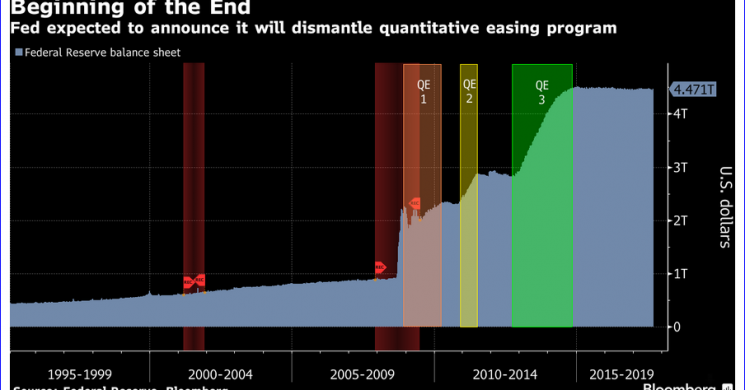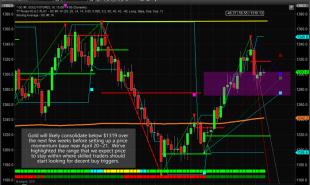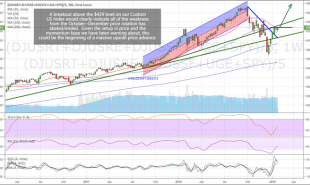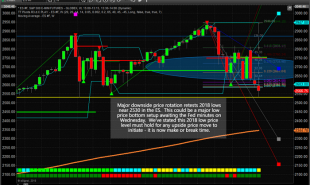
Fed Meeting Today
At 2 p.m. Eastern Time the Federal Reserve will publish its latest monetary-policy decision. While markets are expecting no change to rates, investors will be looking for details on how the central bank intends to start shrinking its $4.5 trillion balance sheet as well as the so-called dot plot, which indicates the path ahead for interest-rate increases. The announcement will be followed 30 minutes later by a press conference with Chair Janet Yellen. Market futures show a rate hike by the end of the year is seen as a coin-flip by investors.
Gold is firmer from overnight giving a nice little break upward on a trend system followed. Recent Fed meetings have been good for Gold and this may be some money covering shorts, punting long ahead of that happening again. There is a lot of air between here and significant resistance to be sure, but that is because we fell so fast in the past week.
Weekly chart with monthly trendlines shown
(click for live)
The focus rate wise will be on on whether the fed reduces its expected rate hike slope going forward. WE don't really know what she will say, but what she or her successor will do will in no way be able to catch up with these projections from her 2016 speech at Jackson Hole. For perspective here is a chart Janet Yellen showed us then giving the projected path of rate hikes.
This was much criticized for any number of reasons. Simplest to see is the wide berth she gave herself, and some commented then that "If this were baseball, she'd be batting 9th with a .187 B.A. But she's an economist, so why are you surprised?" Right now rates are in the 1% area in mid Q3 2017, well below the median projected from the truck driver's berth she gave herself of 1.75% at this point ( give or take another 1.5% lower to 3% higher). Essentially giving a margin of error of over 100%.
Markets waiting
Equity markets across the world remain quiet ahead of the Fed’s decision. Overnight, the MSCI Asia Pacific Index rose 0.2 percent, while Japan’s Topix index was little changed. In Europe, the Stoxx 600 Index was unchanged at 5:40 a.m., and S&P 500 futures were also holding steady. The 10-year Treasury yield was at 2.225 percent and gold was up $3-4 for in cash markets.
For those seeking a more in-depth preview, here courtesy of RanSquawk, is the full "historic" September 20 FOMC Preview.
- FOMC likely to maintain rates between 1.00-1.25%; there will be focus on whether it flattens the rate hike trajectory
- The formal announcement of balance sheet reduction is expected; it’s unclear what size the Fed wants to return it to
- Growth and unemployment projections unlikely to see major changes; inflation may be trimmed again
RATES
- Money markets price a very slim chance that the FOMC will hike rates this week, with an overwhelming 98.6% implied probability that the Federal Funds Rate target will remain between 1.00% to 1.25%. Looking ahead, markets now assign a 58% chance that rates will be lifted again in 2017.
- Federal Funds futures currently price in just two more hikes over the Fed’s current forecast horizon; the FOMC’s June forecasts pencilled in seven rate rises over that timeframe. Note, this week’s forecast will extend the horizon out to 2020.
- Given the cautious tone of comments from FOMC participants in recent weeks, it will be interesting to see whether the central bank lowers its trajectory for the rate path down, in line with the market’s view. However, analysts at Barclays do not expect a major revision to the median view of the rate profile, but sees the average falling: “We expect the median policy path to remain unchanged, but the average policy path should decline. We believe the average funds rate will decline by 15-25bp across the forecast horizon, and we believe as many as seven participants may signal that they prefer no further rate hikes this year (against nine participants who view one or more as appropriate).”
BALANCE SHEET
- It is an almost a forgone conclusion that the FOMC will formally announce the start of its balance sheet programme; indeed, ‘several’ were ready to make the announcement in July. The Fed has also been given some leeway not that the debt ceiling has been extended until December.
- In June, the FOMC suggested a plan where it will allow $6bln of maturing Treasuries and $4bln of maturing MBS to roll-off per month for a three-month period; that amount would then be raised to $12bln for Treasuries and $8bln for MBS for another three months, and after a year, redemptions would be capped at $30bln for Treasuries and $20bln for MBS per month.
- The plan ensures the Fed wouldn’t have to outright sell any of its holdings immediately, which would cause a market reaction. In fact, Fed commentary suggests that the central bank wants to avoid any “shock and awe”; Loretta Mester (non-voter) said the intention is to set the policy, then “forget it”, suggesting that balance sheet would not be an active policy tool.
- Some questions remain unanswered; for instance, what size the FOMC is ultimately seeking to cut the balance sheet to. It is currently around $4.5trln; pre-crisis, it was around $800mln, but it is unlikely that the Fed intends to bring it down to that size. It seems as though the FOMC is still undecided: William Dudley (NY Fed, permanent voter) sees the balance sheet falling to between $2.4trln and $3.5trln – a wide range, but there doesn’t seem to be any firm consensus as yet.
STAFF ECONOMIC PROJECTIONS
- The Fed meets amid an improving tone in US economic data: The labour market has been ticking along nicely for some time, with the rate of joblessness beneath the Fed’s estimate of NAIRU. The second estimate of growth in Q2 was revised higher to 3.0%, well above the Fed’s longer-term view between 1.8% and 2.0%. Inflation has been the Achilles heel, but there are some signs of improvement here too. Recent CPI data showed upside surprises to headline and core rates; but the Fed’s preferred measure – core personal consumption expenditures – lingers at the lowest since Q4 2015 at (1.4% vs Fed’s June forecast of 1.7% in 2017); additionally, wage growth continues to disappoint, which may give the Fed ammunition to remain dovish.
- Analysts at Oxford Economics say “a key focus will be on the FOMC’s view of recent inflation readings and its degree of conviction about whether inflation will hit the 2% target over the medium-term,” adding “this in turn will underpin the committee’s decision about raising rates further this year and the pace of rate increases next year.” FOMC Chair Janet Yellen has previously attributed the weak inflation to temporary factors and called for patience. Many will look out for commentary on whether the Committee has reached a consensus on the extent to which low inflation is transitory, and how much patience should be extended. The likes of Neel Kashkari (voter, dovish) expressed outright concerns on inflation, whereas centrists like William Dudley see a return to target in the medium-term; others, like Robert Kaplan (voter) want to see more evidence before committing to a tighter monetary policy path.
- It is worth noting that the Fed’s forecast horizon will be extended out to 2020, and the FOMC’s June forecasts and the current market view are generally in line, with the exception of inflation, suggesting growth and unemployment forecasts will be little changed, though its short-term inflation views may be cut.
PRESS CONFERENCE WITH CHAIR YELLEN
- Chair Janet Yellen will likely adopt her usual balanced approach in her press conference, according to SGH Macro Advisors, to ensure that the FOMC still has the option of a rate hike in 2017. “She will certainly give voice to dovish concerns over the persistence in low inflation and the possibility of a new inflation dynamic emerging,” SGH says, “but on balance, we still expect her to modestly tilt her remarks to a base rate path that would warrant a possible third-rate hike in December.”
- In addition to inflation, the Fed’s forecasts, and the immediacy of near-term rates hikes, Yellen may also be quizzed on FOMC personnel following the early resignation of Stanley Fischer. Tradition dictates that outgoing Governors do not usually attend the last meeting of their term; however, the Fed has confirmed that Fischer will be in attendance, though it is unclear whether he will be submitting economic forecasts.
- The upshot of Fischer’s resignation means that there would be four vacancies on the Fed’s Board of Governors; but additionally, there remains doubt around Chair Yellen’s own position when her term expires next year, and on top of that, the position of President of the Richmond Fed (which will have a vote in 2018) remains unfilled.
Read more by Soren K.Group









